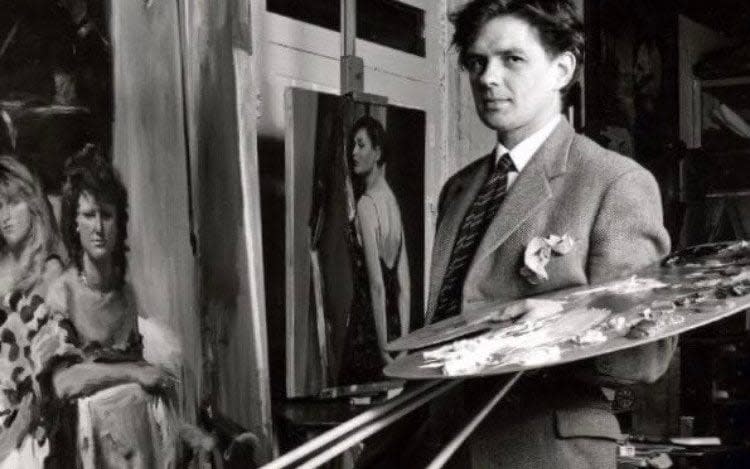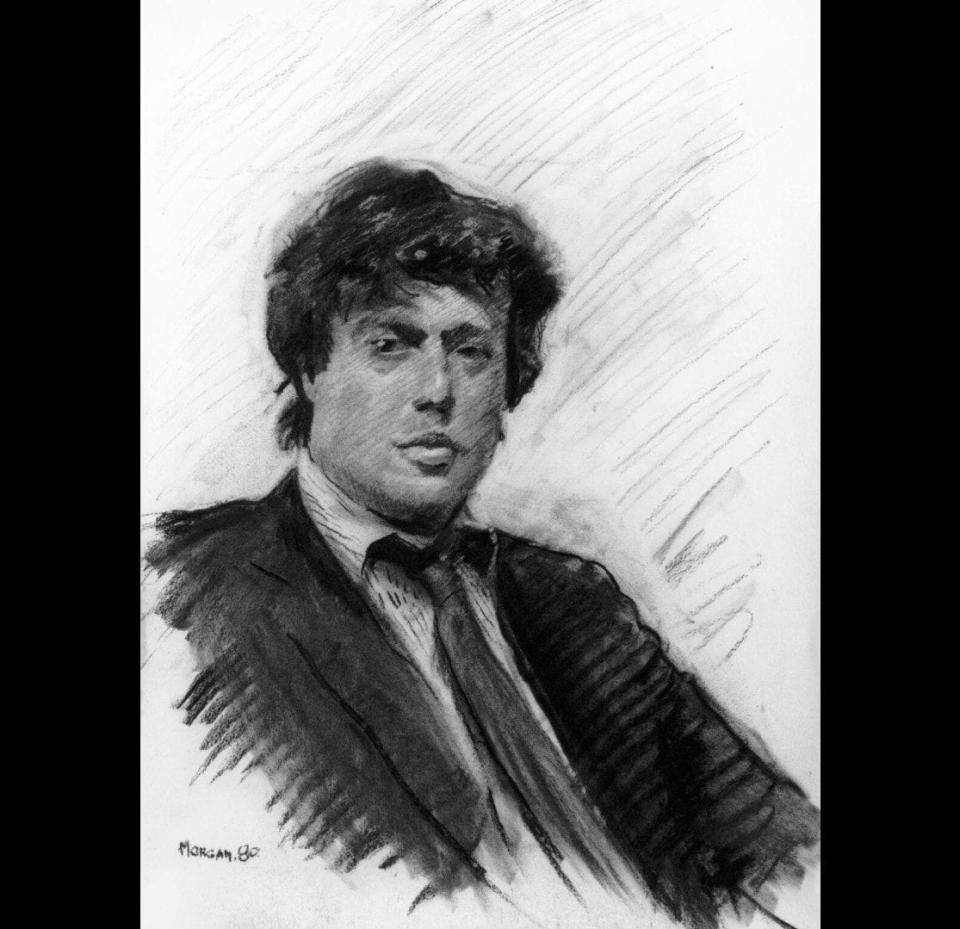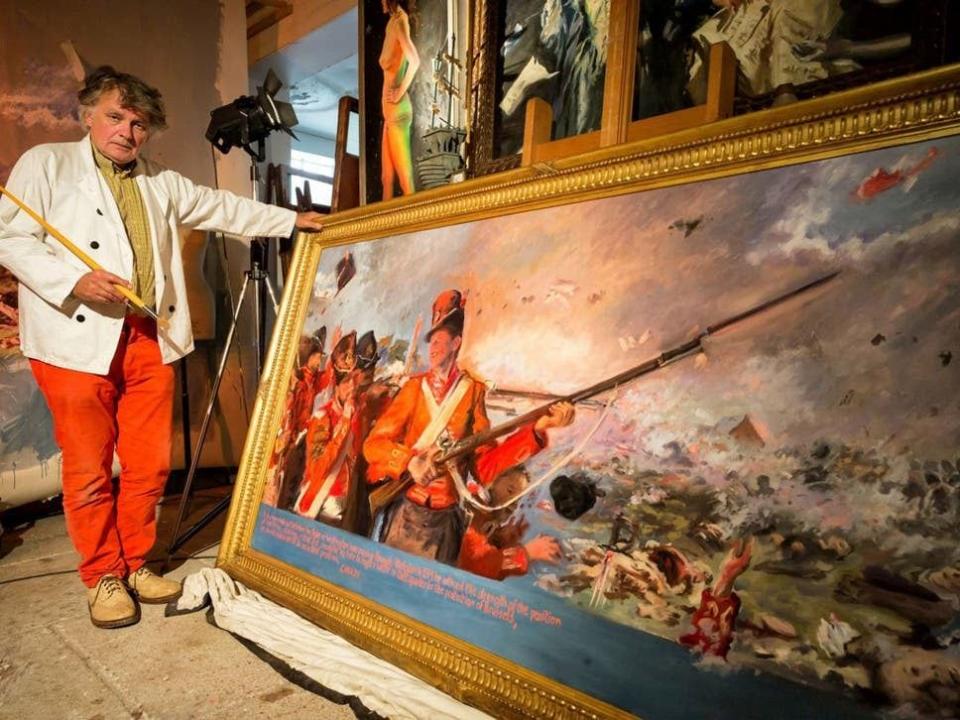Howard Morgan, ebullient portraitist who painted the Queen and other society figures – obituary

Howard Morgan, who has died aged 71, was an artist considered one of the most daring of modern portrait painters, whose fluent and bravura technique and singular character marked him out as one of the greatest society portraitists of his age.
In the 1980s Morgan famously painted three Queens; Elizabeth II, the Queen Mother and Queen Beatrix of the Netherlands. For the first of these, he was typically ebullient, dodging the Queen’s request to include 20 torchères in the background of the painting at Buckingham Palace by warning her that she would look like “a demented antiques dealer from the King’s Road”.
Morgan said he found the Queen quite different in private than in public: “She talks like an Italian, she waves her hands around. She was always gesticulating when you spoke to her.”
Morgan was a friend to many in the Conservative Party, and the swaggering brio and virtuoso effects of his conversation pieces were hugely popular during the 1980s at a time when politicians, aristocrats and writers embraced his socially self-confident and, occasionally, sexually suggestive, paintings.
Watching him paint was a fascinating experience: he attacked the canvas with ferocity, handling foot-long paint brushes, moving back and forwards with a kinetic energy, forever telling stories or singing the hymns and sea shanties of his youth.
In a 2014 interview with the Daily Mail he recalled how, when painting the Queen Mother at Clarence House in the late 1980s, he accidentally kicked one of her corgis which flew through the air before landing in a crumpled heap: “It was like seeing a furry rugby ball cartwheeling between us. I was struck dumb. I didn’t know what to say.” Luckily no harm was done.

Morgan was steadfast in his belief that certain traditional methods got the best results. Eschewing modern shortcuts, he painted from life and never from photographs. For his large conversation pieces, many harking back to the convivial scenes of Hogarth, this meant his studio resembled the stage set of a London theatre.
To give flavour to his imaginary backdrops he would hire up to ten actors, for eight weeks at a time, dressing them up in an extraordinary array of costumes. “I worry about getting bored of painting people’s portraits,” he said earlier this year, “so I like to add some drama.”
Morgan took a serious interest in the artistic practices of the past to inform his technique. He refused to use modern machine-made paint and brushes, preferring the laborious process of grinding his own paint, believing this created stronger colours and a thicker, more stable, impasto, to give his painting permanency.
Brilliant at painting with lead white, he bought three tons of it before it was banned in 1992, a lifetime supply which he kept in bags on the staircase outside his Battersea studio, leading to altercations with his furious landlord.
Morgan’s traditionalism and independence of character were not in keeping with the fashionable views of London art critics, though he had a select band of admirers. The Financial Times critic William Packer observed that although he confronted different genres “head on and on a scale ambitious enough to invite a fall. It is hardly necessary to say that he stays well on his feet.” The art historian Richard Ormond described him as “one of the masters of the 20th century”.
“He was a proper painter in a climate where there are not many,” the art dealer and broadcaster Philip Mould said of him. “He belonged to the virtuoso tradition of Lawrence, Sargent and de Lazlo. Anyone tuned into portrait painting realised they were dealing with someone special.”
Howard James Morgan was born on the April 21 1949 in Denbigh, North Wales, the only child of Thomas and Olive Morgan. His father was a devout lay preacher, who would go onto Rhyl beach to sermonise to passing holidaymakers. Despite a lack of artistic inclinations in the family, Morgan was drawing of his own accord from an early age.

At Fairfax High School, Sutton Coldfield, where his father became deputy headmaster, Morgan was thrown out of art lessons “as the teacher said I was spoiling the classes for the others by taking all the attention”, but he was saved by the arrival of a new art teacher.
Morgan studied art at the Newcastle Fine Art Department, which had long been run on radical and unstructured lines by Victor Pasmore and Richard Hamilton. “It saw itself as the avant-garde,” Morgan recalled, “but fortunately it still had remnants of the ancien regime.”
He caught the eye of Leonard Evetts, who, on hearing that Morgan was using paints from the shop downstairs said “not any more, my boy, you will make your own paint from now on”.

Evetts instructed Morgan in the technical side of painting, from tempera, fresco, stretching and lining to making paint, unfashionable skills that Morgan honed throughout his career. “I am not puritan,” Morgan said, “but whilst all my contemporaries were doing the modern idea of art, the abstract and conceptual, I was getting taught the fundamentals, and it was invigorating.”
Despite his father’s reservations at him becoming an artist, he moved to London after university, lodging in the church of Saint Peter’s, Vauxhall. Arriving with just a rucksack and £200, he was forced to make his own way.

It was here that he met Peter (now Lord) Lilley, a member of the congregation, who won Morgan his first commission: a portrait of the former Prime Minister, Alec Douglas-Home, for the Carlton Club. “He had this extraordinary ability to capture the essence of a person,” Lilley recalled. “Alec Douglas-Home was like a walking skeleton, and in his portrait you can see the skull beneath the skin.”
In 1982, Princess Antonia, Marchioness of Douro, commissioned Morgan to paint murals for the private dining room at Aspley House. She propelled him into London society, and it was at Apsley House that Morgan met the art dealer Anthony Mould, who bought Morgan’s first self-portrait for NatWest Bank, “probably the best thing he ever painted,” said Mould (although many say it is his conversation piece of his beloved Chelsea Arts Club). Morgan and Mould organised three exhibitions together, one held in Claridge’s with a riotous opening party; “it beggared us both,” said Morgan.
This was the first showing of Morgan’s series of jazz paintings, some featuring his friend, the musician George Melly. The star of the show, a large triptych of the Golden Gate Quartet, was bought by Andrew Lloyd Webber.
Although he claimed his horse Doric was his only friend, Morgan was a great conversationalist, affable and willing to shock and tease, and he made friends quickly. Famous sitters included Tom Stoppard, Paul Dirac and Philip Larkin, but he was just as passionate painting “forgotten people”.

Like Sargent, he was a fine watercolourist and in later years he liked rise early to capture the sunrise from his Shropshire garden. He was unapologetically old fashioned; in his studio he would bring in tea and biscuits on a trolley, and he was a lover of history, jazz and old cars.
His narrative paintings, such as his reconstruction of The Climax of the Battle of Waterloo, painted for the Marquess of Douro, were remarkable for their accuracy.
In 1977 he married Susie Sandilands, a designer, and they had three children, Alexander, Romilly and Bo. After they divorced, he married Sarah Milligan, an abstract painter, and they had three children, twins, Perseus and Velvet, and then Samuel.
Born to the brush, Howard Morgan was buried with his paints, palette and brushes.
Howard Morgan, born April 21 1949, died September 22 2020

 Yahoo News
Yahoo News 
